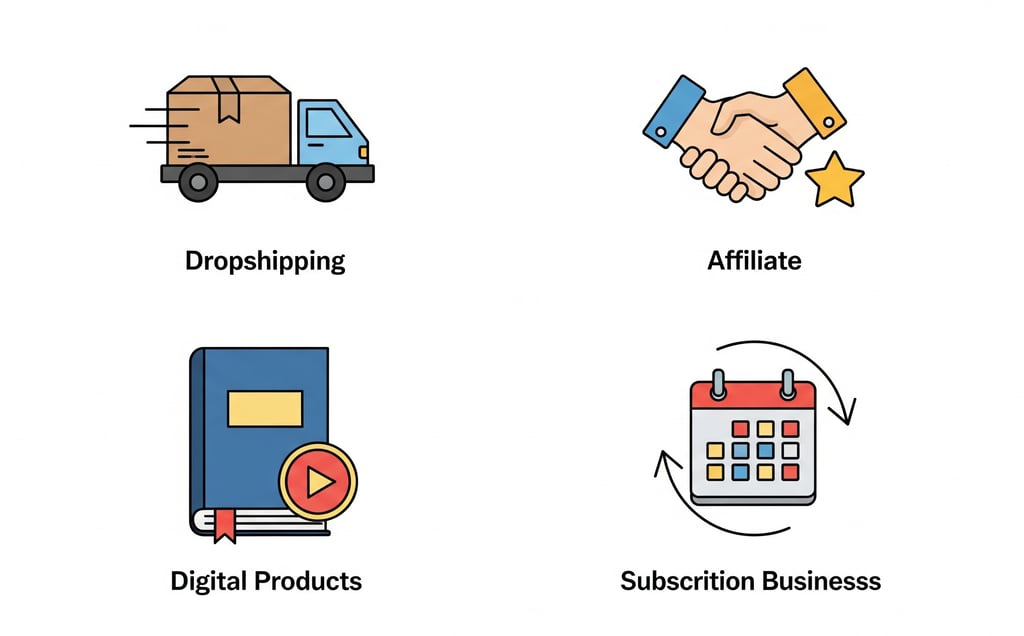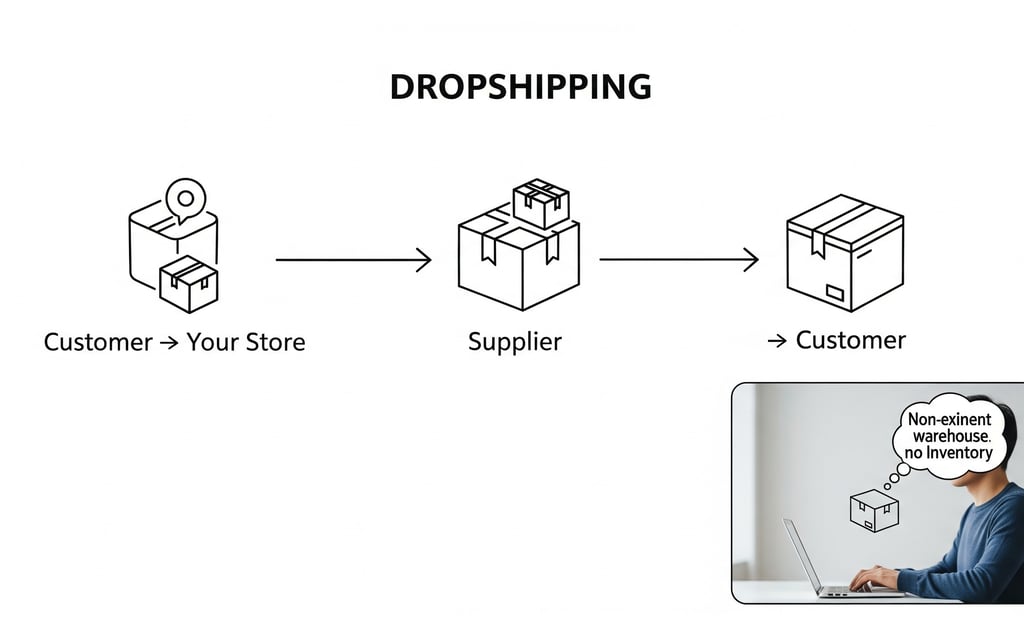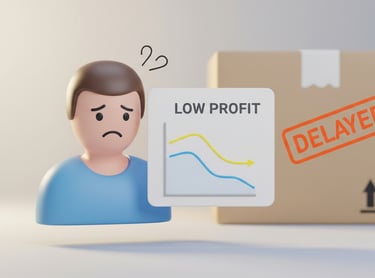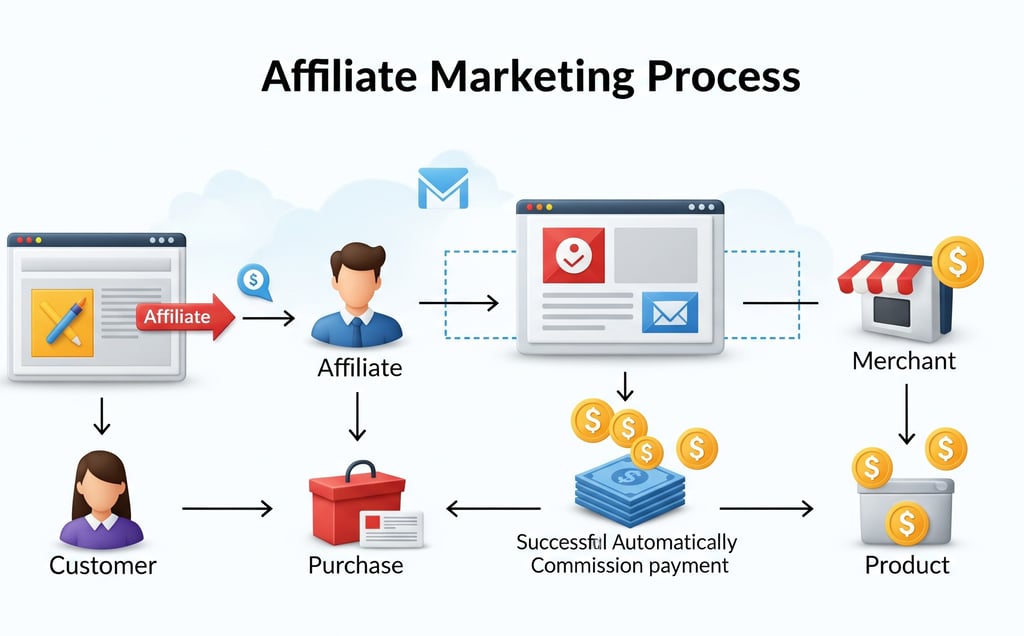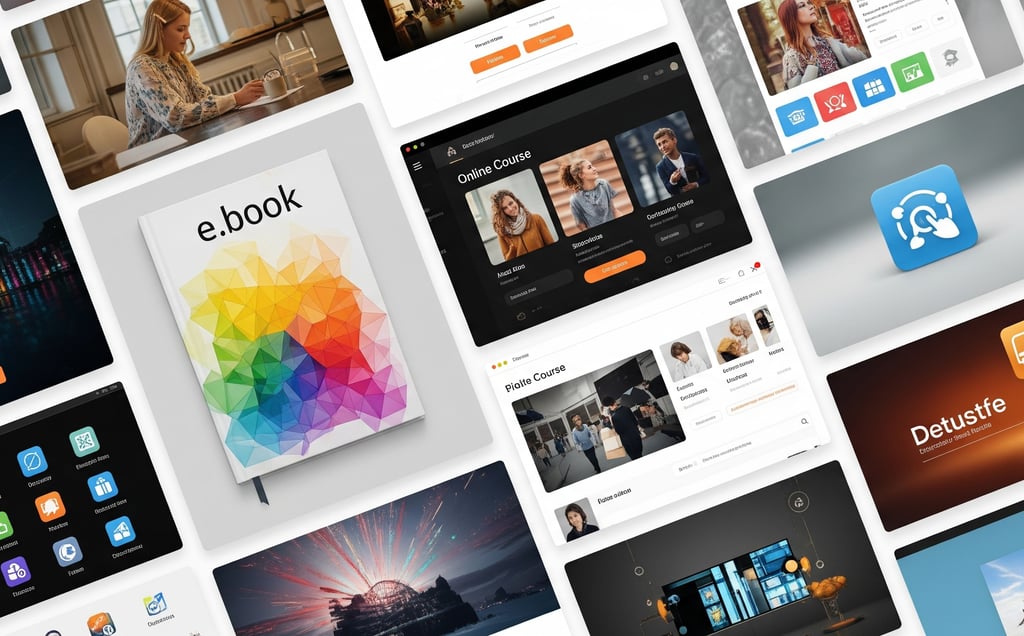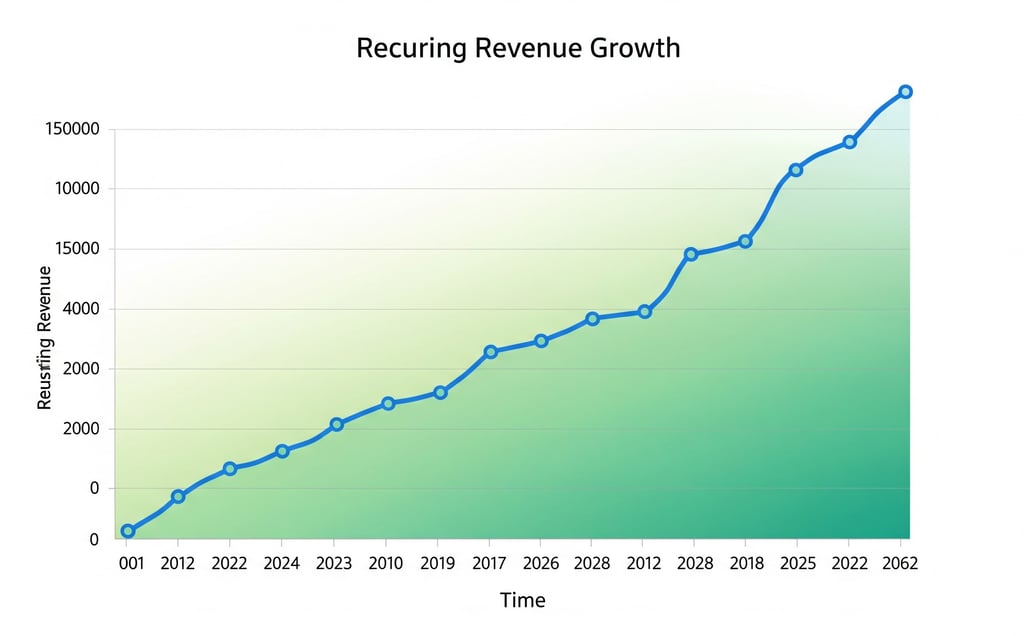How to Choose the Right Online Business Model for Success
Choosing the right online business model is crucial for success. Learn how to choose the right online business model for success by comparing dropshipping, affiliate marketing, digital products, and subscriptions to find your perfect fit.
Eddy Enoma
6/16/202515 min read
Beyond the Hype, A Strategic Guide to Selecting Your Ideal Online Venture
The internet has completely changed how we do business. Gone are the days when starting a business meant you needed a physical shop. Today, with a laptop and a good idea, you can reach customers worldwide. Online businesses often mean lower startup costs, the ability to sell to more people, and a lot more freedom in how you work.
But with so many ways to make money online, how do you pick the right one? This guide will walk you through some of the most popular online business models. We’ll look at what makes each one tick, the good and the bad, and how you can get started. By the end, you’ll have a much clearer idea of which path might be your road to online success.


First Things First: What Are We Talking About?
Before we jump into the different types of online businesses, let’s quickly see what’s on the menu:
Dropshipping: You sell products you don’t keep in stock. A supplier handles that.
Affiliate Marketing: You earn money by recommending other companies’ products.
Selling Digital Products: You create things like e-books or online courses and sell them.
Subscription-Based Businesses: Customers pay you regularly (like monthly) for a product or service.
Each of these has its own set of pluses and minuses. Let’s explore them one by one.
1. Dropshipping: Your Online Store Without the Storage Headaches
What is Dropshipping, Anyway?
Dropshipping is like running an online shop, but you don’t need a warehouse full of products. When a customer buys something from your website, you simply pass the order to your supplier. The supplier then packages the product and ships it directly to the customer. Your main job is to market your store and keep your customers happy.
The Good Stuff (Pros):
Low Startup Costs: This is a big one. You don’t need to buy tons of products upfront. This means you can start with less money.
Lots of Products to Choose From: You can offer a huge variety of items because you’re not storing them yourself. Want to sell phone cases today and pet toys tomorrow? You can!
Work From Anywhere: As long as you have internet, you can run your dropshipping business from your couch, a coffee shop, or even a beach.
Easy to Grow: If you start getting more orders, you don’t have to worry about packing and shipping more stuff. Your supplier handles the increase.
The Not-So-Good Stuff (Cons):
Smaller Profits: Because you’re buying from a supplier who then ships for you, your profit on each sale is usually less than if you bought in bulk and handled everything yourself.
Stock Issues: You’re counting on your supplier to have products in stock. If they run out, you might have to tell a customer they can’t get what they ordered, which is never fun.
Shipping Can Be Tricky: You don’t control shipping times or quality. If your supplier is slow or sends out a damaged item, your customers will blame you.
Lots of Competition: Because it’s easy to start, many people try dropshipping. This means you need to work hard to stand out.
Finding Suppliers You Can Trust:
Your suppliers are super important in dropshipping. Good ones make your life easy; bad ones can ruin your business. Here’s where to look:
Platforms like SellTheTrend (for Shopify stores): These tools help you find products from places like AliExpress and easily add them to your store.
Wholesale Directories: Websites like Worldwide Brands or SaleHoo list suppliers who are often vetted.
Talk to Manufacturers Directly: Some companies that make products are happy to dropship for you.
Niche Suppliers: If you’re selling something specific, like eco-friendly products, look for suppliers who specialize in that area. They often have better quality items.
Interesting Fact: The dropshipping market is booming! As of 2025, it’s valued at over $350 billion and is expected to reach nearly $500 billion by 2027. This massive growth shows just how popular and powerful the dropshipping model has become in today’s digital economy.
Marketing Your Dropshipping Store:
Just having a store isn’t enough; people need to find it!
Social Media: Use sites like Instagram, Facebook, and TikTok. Show off your products, run contests, and connect with potential customers. Tools like Metricool can help you manage all your social media in one place.
Make Your Store Easy to Find (SEO): Write good product descriptions and use keywords people search for so your store shows up on Google. If you need help with SEO-optimized content, Ranked AI can assist in creating content that search engines love.
Paid Ads: You can pay for ads on Google or Facebook to get your products in front of people who are likely to buy. For eye-catching ad visuals, Adcreative AI can generate stunning options in minutes.
Work With Influencers: These are well-known people on social media who can help spread the word about your products. If you’re looking to collaborate with creators, especially for authentic user-generated content (UGC), Insense is a solid platform to explore. You can connect with over 20,000 vetted creators across the US, UK, Canada, and Europe.
Plans start around $100 per video, and if you decide to join through this link, you’ll get up to a $200 credit added to your account.Email Marketing: Collect email addresses from visitors and send them newsletters with special offers or new products. Tools like EmailOctopus offer free, affordable, and easy-to-use email marketing services. Check out my full review here. GetResponse is another powerful option for more advanced email campaigns and automation. You can read my detailed breakdown here
Current Trend: TikTok is a huge driver for dropshipping trends. Viral videos can make a product a bestseller overnight. Tools like PipiAds help you see what ads are performing well on TikTok, giving you ideas for your store.
2. Affiliate Marketing: Earn by Recommending
How Does Affiliate Marketing Work?
Affiliate marketing is like being a matchmaker. You connect people who want to buy something with companies that sell it. If someone buys a product using your special recommendation link (called an affiliate link), the company pays you a thank-you fee, which is a commission. You don’t deal with products or customers directly; you just make the introduction.
Who’s Involved?
The Merchant (or Advertiser): This is the business that has the product or service.
The Affiliate (or Publisher): That’s you! You promote the merchant’s stuff.
The Consumer: The person who clicks your link and buys something.
The Affiliate Network: These are platforms like ShareASale or Amazon Associates. They connect merchants with affiliates and handle the tracking and payments, so everything is fair.
Where to Find Affiliate Programs:
Amazon Associates: Super popular, especially for beginners, because Amazon sells almost everything.
ShareASale and CJ Affiliate: These networks have thousands of businesses you can partner with, from big brands to small shops.
ClickBank: Great for digital products like e-books and online courses.
Software and SaaS Companies: Many software companies (like web hosting or email marketing services) have affiliate programs that pay well, often every month as long as the customer stays subscribed.
Individual Company Programs: Lots of brands run their own programs. If you love a product, check their website for an “Affiliates” or “Partners” page.
Want to learn the ropes of affiliate marketing? There are courses out there that can teach you the A to Z. Check out this “Super Affiliate Marketing Income” HD Video Training Course on Digistore24 or the “Super Affiliate Marketing Mastery” course on ClickBank.
Tips to Earn More as an Affiliate:
Pick a Niche: Don’t try to promote everything. Focus on a topic you know and love, like cooking, gardening, or tech gadgets. This helps you attract the right audience.
Create Awesome Content: Write helpful blog posts, make interesting videos, or create useful reviews. Don’t just throw links around; give people real value. For creating content, especially if you’re not a writing expert, AI tools can be a lifesaver. Rytr or Jenni AI can help you draft articles and product descriptions. SEOWriting AI is specifically designed for creating SEO-friendly content. If you prefer video, Pictory (Use promo code: make20) or Invideo can turn scripts or articles into engaging videos.
Build Trust: People buy from those they trust. Be honest about your affiliate links. Let your audience know that you might earn a commission if they buy through you.
Use More Than One Program: Don’t rely on just one source of affiliate income. If one program changes its rules or shuts down, you’ll still have others.
Track What Works: Pay attention to how many people click your links and how many buy. This helps you understand what your audience likes.
SEO and Social Media are Your Friends: Help people find your content by using SEO techniques. Share your articles and videos on social media. Tools like Surfer SEO or Mangools can boost your SEO game. For YouTube, TubeBuddy and VidIQ provide excellent analytics and optimization tips. You can even promote your YouTube videos using services like Veefly.
Get Traffic: To make sales, you need visitors. Udimi is a place to buy solo ads (email blasts to other people’s lists), while TrafficBuildr and Trafficzest offer other ways to drive visitors to your offers.
Capture Leads: Use tools like ConvertBox to create on-site messages and opt-in forms to grow your email list.
Interesting Fact: Over 80% of brands use affiliate marketing. This means there are tons of opportunities out there for affiliates in almost any niche you can think of!
3. Selling Digital Products: Create Once, Sell Forever (Almost!)
What Are Digital Products?
Digital products are things you create and sell online that people can download or access, but can’t physically touch. Think e-books, online courses, software, music, or even templates for resumes or social media posts. The beauty is, you often create it once, and you can sell it over and over again. This can lead to what many call “passive income”, money that comes in even when you’re not actively working.
Types of Digital Products You Can Sell:
E-books and Guides: Share your knowledge on a topic, write a novel, or create a recipe book. Tools like Automateed AI can even help you write full e-books or novels, making it easier to create content you can sell online.
Online Courses and Workshops: Teach skills through video lessons, tutorials, and downloadable worksheets. Guidde is a fantastic tool for easily creating video documentation and how-to guides that can form the basis of a course.
Templates and Worksheets: Design resume templates, social media graphics, business plan outlines, or budgeting spreadsheets.
Software and Apps: If you’re techy, you could develop mobile apps, desktop software, website plugins, or themes. Or, if coding’s not your thing, tools like Lovable AI let you build fully functional apps just by sharing your idea, no code needed.
Music and Audio: Sell stock music for videos, sound effects, podcasts, or audiobooks. For creating realistic AI voiceovers, ElevenLabs or HumanTalk can be very useful.
Photography and Art: Sell your photos as stock images, create digital art prints, or design illustrations.
Fonts and Graphics: Design custom fonts, icons, logos, or other graphic elements. Canva is a popular tool that many use to create these, and it also has a great affiliate program.
Video Content: Create unique videos with tools like VideoCreator, HumanPal, which offers AI human presenters, VideoExpress AI for quick video creation, or Doodle Maker for animated doodle videos. Vidau AI and Vizard AI are other AI-powered video tools. You can even repurpose existing videos into blog posts using VideoToBlog AI. For advanced AI avatars in your videos, check out HeyGen.
Platforms for Selling Your Digital Goods:
Gumroad or SendOwl: Simple platforms that make it easy to sell digital files.
Etsy: Known for handmade items, but also great for digital art, templates, and planners.
Teachable or Thinkific: If you’re selling online courses, these platforms are built for that.
Your Own Website: You have the most control if you sell from your own site. You can use WordPress with a plugin like Easy Digital Downloads. For building a website quickly, especially with AI assistance, look into 10Web AI. You’ll also need reliable web hosting like Hostinger or WebHostMost.
ThriveCart: ThriveCart is a powerful shopping cart platform that’s excellent for selling digital products and creating sales funnels.
Pricing and Marketing Your Digital Creations:
Price Based on Value: Think about how much your product will help your customer, not just how long it took you to make.
Offer Different Tiers: You could have a basic version and a premium version with more features or support.
Bundle Products: Sell a few related products together for a discounted price.
Launch Sales: Offer special deals when you first release a product to get some early sales and reviews.
Content Marketing: Create free content (blog posts, videos) related to your product to attract people who might be interested. Content Studio can help you discover, plan, and share content.
Build an Email List: This is super important! Offer something free (like a short guide or a checklist) in exchange for email addresses. Then you can tell people about your products. (Refer back to EmailOctopus and GetResponse).
Run Webinars or Free Workshops: Show off your expertise and then offer your paid product at the end.
Use Affiliates: Let other people promote your digital products for a commission, expanding your reach.
Current Trend: AI-generated content and tools are now becoming digital products themselves. People are creating and selling things like AI art prompts, custom GPT chatbots (using platforms like CustomGPT.ai or Chatbase.co), and even specialized AI tools built with platforms like Pickaxe.
4. Subscription-Based Businesses: The Power of Recurring Revenue
What’s a Subscription Business?
In a subscription model, customers pay you a regular fee (usually monthly or yearly) to get access to a product or service. Think Netflix for movies, Spotify for music, or those boxes of goodies that arrive at your door each month.
Why Subscriptions Are Awesome:
Steady Money: You get a predictable stream of income, which makes planning your business finances much easier.
Happy, Loyal Customers: When people subscribe, they’re often looking for a long-term relationship with your brand.
Customers Spend More Over Time: A subscriber is likely to spend more with you over their lifetime than someone who just buys once.
Easier Planning: Having a rough idea of how many customers to expect helps you manage inventory (if you sell physical products) or server capacity and bandwidth (if you offer a digital service).
More Sales Opportunities: It’s often easier to sell new products or upgraded plans to existing subscribers.
Learn About Your Customers: Regular interaction gives you lots of info about what your customers like and don’t like.
Examples of Successful Subscription Ideas:
Streaming Services: Netflix, Disney+ (access to movies and shows).
Software as a Service (SaaS): Tools like Microsoft 365, Adobe Creative Cloud, or project management software like Taskade AI. Even AI writing assistants like Jenni AI or developer tools like Loveable.dev often use a subscription model.
Subscription Boxes: Companies like Birchbox (beauty samples) or Blue Apron (meal kits) send curated boxes of physical products.
Membership Websites: Offer exclusive content, online communities, or forums for a monthly fee.
News and Magazines: Many online newspapers and magazines offer subscriptions for access to their articles.
Fitness and Wellness Apps: Peloton, Calm (access to workout classes, meditation guides).
Keeping Your Subscribers Happy (and Paying!):
Getting subscribers is one thing; keeping them is another. This is called “retention.”
Always Deliver Value: Make sure your product or service is consistently great and worth the money.
Top-Notch Customer Service: Be quick to help with problems and answer questions. Consider AI chatbots like Chatbase.co or CustomGPT.ai to provide instant support.
Make it Personal: Try to tailor offers or content to what individual subscribers like.
Build a Community: Create a Facebook group or forum where subscribers can connect.
Easy Start: Make it simple for new subscribers to understand and use your service.
Ask for Feedback: Show you care by asking for their opinions and making improvements based on them.
Reward Loyalty: Give special perks to long-term subscribers.
Be Flexible: Offer different plan levels, or let people pause their subscription if they need to.
Stay in Touch: Send regular newsletters with updates, tips, or helpful content. (Again, EmailOctopus, and GetResponse are great here).
Interesting Fact: The subscription economy has grown by more than 400% in the last decade. People love the convenience and ongoing value that subscriptions provide.
Conclusion: Picking the Online Business Model That’s Right for YOU
So, we’ve looked at four popular ways to make money online. Which one should you choose? There’s no single “best” model; it all depends on you.
Let’s Compare Them Quickly by Looking at Key Features:
Dropshipping:
Startup Cost: This model is known for its low startup costs because you don’t buy inventory upfront.
Inventory Needed?: No, your supplier handles all inventory.
Profit Per Sale: Profits tend to be lower compared to other models, as you’re buying from a supplier who also takes a cut.
Easy to Grow?: Yes, it’s generally scalable as your supplier handles increased order volume.
Passive Income?: It offers a little passive income potential, but still requires active management of marketing and customer service.
Customer Service: You handle it, though your reliance on the supplier can impact customer satisfaction.
Affiliate Marketing:
Startup Cost: This model boasts very low startup costs, often just needing a platform (like a blog or social media) to share links.
Inventory Needed?: No, you’re promoting products owned by others.
Profit Per Sale: Profits vary widely depending on the program and product, but they can be quite good, often a percentage of the sale.
Easy to Grow?: Yes, you can scale by joining more programs or increasing your audience reach.
Passive Income?: Yes, this can be a strong source of passive income once your content and links are established.
Customer Service: Minimal responsibility for you, as the merchant handles customer interactions directly.
Selling Digital Products:
Startup Cost: Costs are generally low to moderate, mainly involving the time and tools needed for product creation.
Inventory Needed?: No, as these are intangible goods.
Profit Per Sale: Profits are typically high because once created, the cost to replicate a digital product is virtually zero.
Easy to Grow?: Yes, digital products are highly scalable.
Passive Income?: Yes, very much so! This model has excellent passive income potential.
Customer Service: You’ll have some customer service responsibilities, mostly helping users with product access or usage.
Subscription-Based Business:
Startup Cost: These can range from moderate to high, especially if you’re developing unique software or a complex content platform.
Inventory Needed?: Maybe. It’s ‘no’ for digital subscriptions, but ‘yes’ if you’re shipping physical subscription boxes.
Profit Per Sale: Profits are high, and the key benefit is that they are recurring, providing a steady income stream.
Easy to Grow?: Yes, these businesses are designed for scalability.
Passive Income?: Yes, very much so! Recurring revenue is a hallmark of strong passive income.
Customer Service: Expect lots of customer service interaction, as maintaining subscriber happiness and retention is crucial.
What to Think About When Choosing:
Your Interests and Skills: What are you passionate about? What are you good at? It’s much easier to build a business around something you enjoy and understand.
Your Budget: How much money can you realistically invest to get started?
Your Time: How much time can you dedicate each week? Some models need more hands-on work than others.
Your Comfort with Risk: Are you okay with potentially losing some money, or do you prefer a safer bet?
Tech Skills: Are you comfortable building a website or learning new software? If not, are you willing to learn or pay someone to help? Many AI tools now make tech tasks easier, for example, 10Web AI can build websites, and TexAu can help automate tasks.
Who You Want to Help (Your Audience): Who are your ideal customers? Understanding them helps you pick the right products or services.
Your Big Goals: Are you looking for a small side income, or do you want to build a large company?
Ready to Start? Here Are Your First Steps
Do Your Homework (Market Research): Is there a demand for your idea? Who are your competitors?
Make a Plan (Business Plan): Write down your goals, how you’ll reach them, your marketing ideas, and how you’ll manage money. For organizing your thoughts and managing projects efficiently, tools like Taskade AI can be incredibly beneficial.
Get Official (Legal Stuff): Register your business name, get any needed licenses, and open a business bank account.
Pick Your Tools: When choosing your platforms, consider options like Shopify or ThriveCart for e-commerce and sales funnels. Check out this detailed guide.
Create or Source Your Product/Service: If you’re selling digital products, get creating! If dropshipping, find your suppliers. If affiliate marketing, join programs.
Tell the World (Marketing): Develop a plan to get your business in front of potential customers. Your marketing plan might leverage social media, SEO (with tools like Surfer SEO or Content Studio for content strategy), paid ads, or email marketing
Launch and Learn: Get your business out there! Don’t wait for perfection. Start, get feedback from customers, and keep improving.
The online world is full of opportunities. By understanding these different business models and thinking carefully about what fits you best, you can take your first steps towards building your own successful online venture. Good luck!
For those seeking additional resources, a comprehensive directory like There’s An AI For That can help you discover AI tools for nearly any business task. If your long-term vision includes buying or selling online businesses, Flippa is a leading marketplace. And for finding skilled freelance support, Fiverr remains a popular choice.
Finally, for structured training and community support in online entrepreneurship, the OLSP System is a valuable resource. For those interested in YouTube, Matt Par’s free training on making money without recording videos offers unique insights. And aspiring writers might find opportunities through GetPaidOnlineWritingJobs
Just a heads-up: This post has some affiliate links, which means I might earn a small commission if you buy through them at no extra cost to you. I only share tools I’ve actually used and found super helpful. They’ve made a big difference for me, and I think you’ll find them useful too!
Ready to grow your online business? Sign up for my newsletter to receive exclusive insights, tool recommendations, and success stories that you won't find anywhere else.
Subscribe for Exclusive Tips & Updates. Enter Your Email Below!



Get the latest strategies on content creation, freelancing, and affiliate marketing, plus passive income straight to your inbox!
🔒 We respect your privacy. Your email is safe with us. Unsubscribe anytime.
Address
Sporerweg 16
94234 Viechtach, Germany
Contacts Us
(049) 170 499 6273
Subscribe to our newsletter
© 2026 Onlinebizoffers. All rights reserved.



